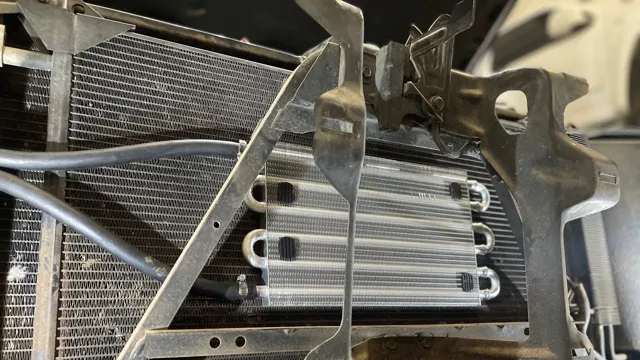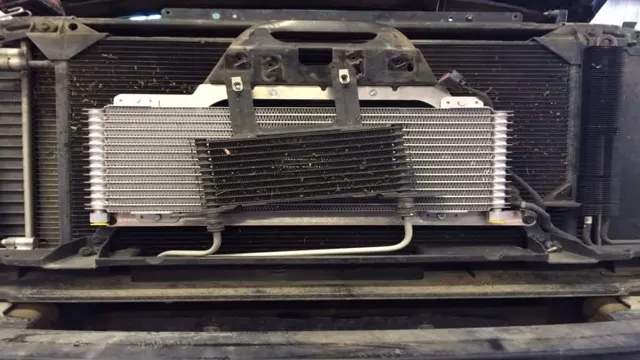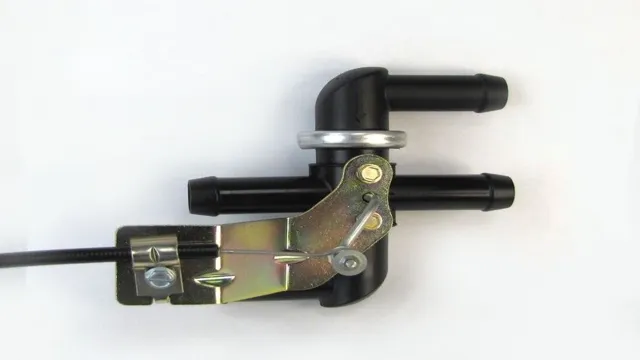Master the Art of Installing Aftermarket Transmission Cooler with These Step-by-Step Instructions
Are you planning on taking your vehicle on a long trip or towing heavy loads? Or has your original transmission cooler failed, and you’re looking to upgrade to an aftermarket one? Whatever the reason, installing an aftermarket transmission cooler is vital to keep your transmission from overheating, which can lead to costly repairs. In this blog, we’ll cover everything you need to know about installing an aftermarket transmission cooler, including the benefits, the installation process, and the factors to consider when choosing the right cooler for your vehicle. So buckle up, and let’s dive in!
Benefits of an Aftermarket Transmission Cooler
Looking to improve the performance and extend the lifespan of your car’s transmission? Installing an aftermarket transmission cooler is a smart choice. This simple addition can provide many benefits, including reducing strain on your vehicle’s transmission and decreasing the risk of overheating. Additionally, an aftermarket transmission cooler can increase the longevity of your car’s transmission fluid, which in turn saves you money in the long run.
But how do you install one? The process of installing an aftermarket transmission cooler can vary based on your vehicle’s make and model, but generally involves mounting the cooler in an accessible location and connecting it to the existing transmission lines. Seeking help from a professional mechanic or following detailed instructions is recommended to ensure a successful installation. Don’t neglect your car’s transmission – take the proactive step of installing an aftermarket transmission cooler today.
Reduce Transmission Overheating
One of the most common problems with your transmission is overheating. When your transmission overheats, it can cause serious damage to your vehicle and can be costly to repair. One solution to reduce the risk of transmission overheating is to install an aftermarket transmission cooler.
These coolers are specially designed to lower the temperature of the transmission fluid, reducing the risk of damage to your transmission. Not only do they provide protection against overheating, but they also extend the life of your transmission. Additionally, an aftermarket transmission cooler can increase the overall performance of your vehicle.
It can improve the shifting, acceleration, and towing capacity of your vehicle. Overall, investing in an aftermarket transmission cooler is a wise decision that can save you money and increase the lifespan of your transmission.

Extend Transmission Life
An aftermarket transmission cooler can be a great investment for those looking to extend the life of their vehicle’s transmission. These add-ons offer a range of benefits that are well worth considering. For starters, a transmission cooler can prevent your transmission from overheating, which can cause serious damage.
This is especially important for those who use their vehicles for hauling heavy loads or driving in extreme conditions. Additionally, adding a transmission cooler can help to improve fuel efficiency. By reducing the amount of heat generated by the transmission, the engine can run more efficiently, thus using less fuel.
Overall, investing in an aftermarket transmission cooler is a smart move for anyone who wants to keep their transmission running smoothly for years to come.
Improve Transmission Performance
As a car owner, you may have experienced transmission issues. Whether it’s slipping, overheating, or just not performing as smoothly as it should, a failing transmission can be a major headache. However, there is a simple solution to help improve transmission performance – installing an aftermarket transmission cooler.
Adding a cooler to your transmission system can provide numerous benefits, such as reducing heat buildup and extending the life of your transmission. By keeping the fluid cooler, the transmission is less likely to overheat, reducing the chances of premature wear and tear. An aftermarket transmission cooler also helps to improve fuel economy, as running the transmission cooler can reduce the load on the engine.
So, if you want to avoid costly repairs and replacements, consider investing in an aftermarket transmission cooler for your vehicle. The benefits are worth it in the long run, ensuring your transmission runs smoothly and efficiently for years to come.
Steps to Install an Aftermarket Transmission Cooler
Installing an aftermarket transmission cooler can be a great way to prolong the lifespan of your transmission and improve its performance. Here are the steps you need to take to install an aftermarket transmission cooler. Firstly, choose a location for your cooler that will be easy to access for maintenance, but also allows for optimal airflow.
Then, disconnect the transmission fluid lines from the radiator and connect them to the new cooler using the included hoses and fittings. You may need to bend the lines slightly to fit them onto the new cooler. After that, mount the new cooler securely using the included hardware and ensure all fittings and hoses are properly tightened.
Lastly, refill the transmission fluid to the appropriate level and check for any leaks before testing the vehicle. With these easy steps, you can enjoy a much smoother and longer-lasting transmission that will give you greater peace of mind on the road. So why not give it a try and see the difference it can make for yourself?
Gather Necessary Tools
An aftermarket transmission cooler is a great investment to help keep your car’s transmission running smoothly and avoiding expensive repairs. Before installation, make sure you have all the necessary tools to get the job done right. You’ll need a transmission cooler kit (make sure it’s the right one for your car), a wrench set, screwdrivers, and pliers.
Other helpful tools include a socket set, power drill, and a torque wrench if you want to ensure everything is tightened to the correct specification. It’s also a good idea to have a drain pan and funnel on hand to catch any transmission fluid that may leak during the installation process. With all the right tools at your disposal, you’ll be ready to tackle this DIY job with confidence.
Select the Right Location for the Cooler
When it comes to installing an aftermarket transmission cooler, the right location is crucial. Choosing a suitable spot for the cooler can help ensure optimal performance and longevity of your transmission. One important consideration is airflow – you want to place the cooler in an area that has sufficient airflow to dissipate heat.
It’s also essential to mount the cooler securely, so it doesn’t move around or come loose while driving. One helpful tip is to choose a location near the existing transmission lines, which can make installation simpler and more efficient. Another consideration is the size and shape of the cooler – you want to make sure it fits in the available space and doesn’t interfere with other components in the engine bay.
By following these steps, you can select the ideal location for your aftermarket transmission cooler and enjoy smoother, cooler transmission operation.
Disconnect Existing Transmission Lines
If you’re considering installing an aftermarket transmission cooler, the first step is to disconnect your existing transmission lines. This can be done by locating the transmission lines (usually located near the radiator) and using a wrench to loosen the connections. Make sure to have a container on hand to catch any transmission fluid that may leak out during the process.
Once the lines are disconnected, you can then connect the aftermarket cooler in line with the transmission by running the new transmission lines from the cooler to the transmission. This step is important to ensure that your new cooler is installed properly and will work effectively to keep your transmission cool and running smoothly. Taking the time to properly install an aftermarket cooler can extend the life of your transmission and prevent costly repairs down the road.
Install the Cooler and Mounting Brackets
Installing an aftermarket transmission cooler is a great way to increase the lifespan of your vehicle’s transmission. One of the first steps in this process is to install the cooler and mounting brackets. To do this, you will need to remove the old cooler if there is one, and then install the new one in the same location.
The mounting brackets can then be attached to the vehicle’s frame using screws or bolts. It is important to ensure that the brackets are secure and properly aligned, as this will prevent the cooler from shifting or coming loose while driving. When installing the cooler, it is also important to make sure that the hoses are properly connected and tightened to prevent any leaks or damage.
Overall, following these steps will help ensure that your aftermarket transmission cooler is securely mounted and functioning properly, improving the overall performance and longevity of your vehicle’s transmission.
Connect New Transmission Lines
Installing an aftermarket transmission cooler is an essential step to ensure that your vehicle’s transmission remains cool, especially in high-temperature environments. First, locate the best location to mount the transmission cooler and then make sure the cooler lines are properly connected to the transmission lines. It is crucial that they are mounted correctly so that they can adequately dissipate heat from the transmission and improve the overall efficiency of the system.
Once the cooler has been installed, you’ll need to ensure that it is properly secured to the vehicle’s frame and that the cooler lines aren’t twisted or kinked. It is important to ensure that the cooler is functioning correctly during the installation process by running the vehicle in idle and checking the temperature. An aftermarket transmission cooler can extend the life of your transmission, prevent costly repairs, and even improve fuel economy.
By taking the necessary steps to install an aftermarket transmission cooler, you’ll increase your vehicle’s reliability and performance while protecting one of the most crucial parts of your vehicle.
Tips for Maintaining Your Transmission Cooler
If you’re looking to install an aftermarket transmission cooler, it’s important to understand how to properly maintain it for optimal performance. One of the most important things you can do is regularly check the fluid levels in your transmission. Low levels can put additional strain on your cooler and lead to overheating.
It’s also important to regularly inspect the cooler for any signs of damage or leaks. Finally, be sure to flush the system periodically to keep it clean and free of any debris that could reduce its effectiveness. By following these tips, you can ensure that your transmission cooler operates efficiently and helps extend the life of your vehicle’s transmission.
Regularly Inspect for Leaks or Damage
If you’re looking for tips on maintaining your transmission cooler, inspecting for leaks or damage should be high on your list! Regular inspections can help catch any issues early on, which can save you a lot of time, money, and headache in the long run. To get started, make sure you know where your cooler is located and what it looks like so you can easily spot any signs of damage, such as cracks or dents. Then, check all the connections and hoses to make sure they’re secure and not leaking.
Finally, keep an eye on your transmission fluid levels and color. Low levels or dark, burnt-looking fluid can be a sign that something is wrong with your cooler. By taking the time to inspect your transmission cooler regularly, you can help ensure that your vehicle stays running smoothly.
Check Fluid Levels and Temperature Frequently
Maintaining your transmission cooler is vital to ensure that your vehicle operates smoothly and efficiently. One tip for ensuring optimal performance is to check the fluid levels and temperature frequently. Transmission fluid is responsible for cooling the transmission and acting as a lubricant, keeping all the moving parts working seamlessly.
Low or dirty fluid levels can increase the risk of overheating and cause damage to the transmission, resulting in expensive repairs. Therefore, it is crucial to check the fluid level regularly and change it regularly according to the manufacturer’s recommendation. Monitoring the temperature of the transmission will give you an early warning sign of any potential issues.
If the temperature gauge rises above normal, you should stop your vehicle and allow it to cool down before continuing. By keeping a close eye on the fluid levels and temperature, you can avoid transmission problems and prolong the life of your vehicle.
Conclusion – Keep Your Transmission Running Cool
Congratulations, you’ve now installed an aftermarket transmission cooler with ease and finesse! Your transmission will now stay cool under pressure, keeping your vehicle running smoothly for longer. Just remember, unlike installing that complicated IKEA furniture piece, there’s no leftover parts this time. But as an added bonus, you’ve gained some bragging rights at the next backyard barbecue or car show.
So go ahead, pop the hood and show off your newly installed transmission cooler with confidence and style!”
FAQs
What is an aftermarket transmission cooler?
An aftermarket transmission cooler is an additional cooling system that can be installed in a vehicle to help cool the transmission fluid and prolong the life of the transmission.
Why should I install an aftermarket transmission cooler?
Installing an aftermarket transmission cooler can help prevent the transmission from overheating, reduce wear and tear on the transmission, and potentially save you money on costly repairs.
Can I install an aftermarket transmission cooler myself?
Yes, with a little bit of mechanical know-how, installing an aftermarket transmission cooler can be a DIY project. However, if you are unsure about your abilities, it is recommended to have a qualified mechanic install it for you.
How do I choose the right aftermarket transmission cooler for my vehicle?
To choose the right aftermarket transmission cooler for your vehicle, you will need to consider factors such as the size of your vehicle, the amount of weight it will be carrying, and driving conditions. It is recommended to consult with a professional or do thorough research before purchasing.






